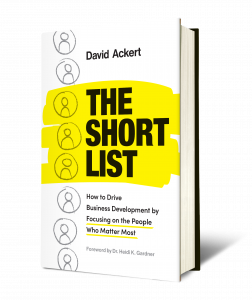44 Business Development Buzzwords You Should Know
In the realm of business development, the utilization of specific terminology or ‘buzzwords’ has become increasingly prevalent. We’ve created an overview of common business development buzzwords, offering insights into their meanings and applications within a corporate context.
- Advertainment: A fusion of advertising and entertainment, this strategy aims to captivate audiences with content that entertains while subtly promoting a product or service, enhancing brand engagement and recall.
- Big Data: Refers to the vast accumulation, processing, and analysis of complex data sets, often beyond the capability of traditional data-processing applications. It’s instrumental in driving decision-making through insights derived from analyzing customer behaviors, trends, and patterns.
- Content is King: A principle emphasizing the pivotal role of high-quality, relevant, and valuable content in driving digital marketing success. It underscores the importance of content in attracting and retaining a clearly defined audience, ultimately driving profitable customer action.
- Customer Journey: This term maps out the complete sequence of experiences a customer goes through while interacting with a brand or company. It includes every touchpoint, from initial awareness and consideration to the final purchase and post-purchase interactions.
- Deep Dive: In-depth analysis or thorough exploration of a particular topic, subject, or problem. It involves a comprehensive and detailed examination to gain a profound understanding or uncover new insights.
- Growth Hacking: Refers to innovative, creative, and cost-effective marketing strategies aimed at rapid business development and growth. It’s particularly prevalent among startups and small businesses, employing unconventional approaches like viral marketing and leveraging social media.
- Hyperlocal: Marketing or advertising intensely focused on a specific, narrowly defined geographic area, often targeting local residents or businesses. It involves creating content or campaigns tailored to the interests and needs of a local community.
- Low-Hanging Fruit: Easily attainable objectives or goals, typically requiring minimal effort but offering significant rewards. It denotes opportunities that are readily achievable and can provide quick results.
- Jacking: The practice of piggybacking on popular trends, news, or content for marketing purposes. Examples include ‘news-jacking’, where a brand capitalizes on current events, or ‘meme-jacking’, which involves using popular memes for promotional activities.
- Move the Needle: A phrase used to describe efforts or actions that bring about significant change or progress in a business development context. It implies making a noticeable difference in achieving business development goals or metrics.
- Retargeting: A digital advertising strategy targeting users who have previously engaged with a brand or visited its website but did not complete a purchase. It aims to recapture their interest and guide them back to finalize a transaction.
- Alignment: The process of ensuring that business development strategies, goals, and actions are harmonized across different departments or teams, particularly in sales and marketing. It’s crucial for ensuring consistency and efficiency in achieving the company’s objectives.
- Disruptor/Disruptive: Refers to products, services, or business development models that radically change industry landscapes by introducing groundbreaking innovations. Disruptive companies often challenge and alter the way traditional markets operate.
- Freemium: A business model where the basic version of a product or service is offered free of charge, while more advanced features or services require payment. This model is prevalent in software and digital services, allowing users to experience the core product before opting for premium features.
- Leverage: Utilizing available resources, assets, or opportunities to maximum advantage, often to achieve business development objectives or gain a competitive edge. It can involve capitalizing on technology, market position, or unique capabilities.
- Quick Win: Refers to tasks or goals that are easy to achieve and don’t require a lot of resources yet have a high impact on the business. Quick wins are important for maintaining momentum and demonstrating progress.
- Quota: A specific sales target or goal set for a salesperson or team to achieve within a certain timeframe. It’s often used as a performance metric and can be based on revenue, the number of deals closed, or other measurable outcomes.
- Value Add: Enhancements or additional features provided in a product or service that go beyond the standard expectations, thereby increasing its overall value to the customer. It’s a strategy to differentiate a product or service in a competitive market.
- Wheelhouse: Refers to an area of expertise, skill, or experience where an individual or organization excels. It’s often used to describe a person’s or company’s strong suit or the area where they are most comfortable and effective.
- Customer Acquisition: The process and strategies used by a company to attract and convert new customers. It encompasses all the marketing and outreach efforts aimed at creating awareness, interest, and engagement among potential customers.
- Customer-Centric/Customer-Centricity: A business philosophy that places the customer’s needs and experiences at the heart of all company operations and decision-making. It involves creating products, services, and experiences that meet or exceed customer expectations.
- Customer Lifecycle: The progression of steps a customer goes through when considering, purchasing, using, and maintaining loyalty to a product or service. It includes stages such as awareness, consideration, purchase, retention, and advocacy.
- Customer Retention: The ability of a business to retain its customers over a period. It involves strategies to keep customers engaged and satisfied, encouraging repeat business and long-term loyalty.
- Personalization: The practice of tailoring products, services, and communications to customers’ individual preferences and behaviors. It’s a key marketing and customer service strategy to enhance customer experience and satisfaction.
- Touchpoint: Any point of contact or interaction between a customer and a brand, whether it’s in-person, online, or through other channels. Each touchpoint represents an opportunity to influence the customer’s perception and experience.
- Voice of the Customer: A market research technique that captures and analyzes customer feedback, expectations, preferences, and aversions. It’s used to inform business development decisions and strategies to better align with customer needs.
- Clickbait: Internet content, particularly headlines, designed to attract attention and encourage visitors to click on a link to a particular web page. While effective in driving traffic, clickbait often lacks substantive content and can be misleading.
- Earned Media: Publicity or exposure gained through promotional efforts other than paid advertising. This includes media coverage, social media mentions, word-of-mouth, and other forms of recognition not directly paid for.
- Live Streaming: The act of broadcasting video content in real-time over the internet, typically via social media platforms. It allows brands and individuals to engage directly with their audience, offering an immediate and interactive experience.
- Micro-Influencer: Social media influencers with relatively small but highly engaged and niche audiences. They are often perceived as more authentic and relatable compared to larger influencers, making them valuable for targeted marketing campaigns.
- User-Generated Content (UGC): Content created and shared by end-users, often on social media platforms or through online communities. It includes reviews, testimonials, images, videos, and other forms of content that reflect real-life user experiences with a brand or product.
- FOMO: ‘Fear of Missing Out’, a psychological trigger used in marketing to create a sense of urgency or anxiety over potentially missing out on a product, experience, or event. It can drive quick decision-making and impulsive purchases.
- Lit: A colloquial term used to describe something as exciting, fun, or excellent. In a business context, it might refer to a product, service, or campaign that is exceptionally well-received or popular.
- Spilling Tea: A slang phrase for sharing gossip, secrets, or private information. In corporate communication, it can refer to the informal sharing of insider knowledge or industry news.
- TL;DR: ‘Too Long; Didn’t Read’. A shorthand notation often used at the beginning or end of an article or post to provide a brief summary of the content, catering to readers who prefer a quick overview rather than detailed reading.
- Bandwidth: In a corporate context, it refers to the capacity or resources (time, energy, or attention) available to an individual or team to take on tasks or projects. It’s often used to assess workload or capability.
- Logistics: The detailed organization and implementation of complex operations, often relating to events, product distribution, or supply chain management. It encompasses planning the who, what, when, where, why, and how.
- Core Competency: A defining strength or primary area of expertise of a business. It’s the unique advantage or capability that sets a company apart from its competitors and is central to its identity and success.
- Ballpark: An estimate or approximation that is not exact but within a reasonable range. Often used in business to provide a general idea or starting point for discussions, negotiations, or planning.
- Return on Investment (ROI): A measure of the profitability and efficiency of an investment. It calculates the ratio of net profit to the cost of the investment, helping businesses assess the effectiveness of their spending decisions.
- Buyer’s Journey: The process that potential customers go through as they discover, evaluate and decide to purchase a product or service. It encompasses awareness, consideration, decision, and post-purchase evaluation stages.
- Visibility: The degree to which a company, brand, product, or service is seen or noticed, particularly in search engine results, social media, or the market in general. It’s crucial for brand awareness and customer acquisition.
- Corporate Synergy: The concept that combined efforts of different departments or entities within a corporation result in greater efficiency, effectiveness, or value than if they operated independently. It emphasizes collaboration and integration.
- Impact: The influence or effect that a business, its products, or its services have on its market, industry, or audience. A strong, positive impact can elevate brand reputation, and attract customers.
The Significance of Keeping Up with Business Development Buzzwords in a Corporate Environment
In the constantly evolving landscape of the corporate world, the language used within industries often serves as more than just a means of communication; it reflects the ongoing trends, innovations, and shifts in market dynamics.
The Role of Buzzwords in Corporate Communication
Buzzwords are often coined to describe new concepts, technologies, or practices that are gaining traction within an industry. They provide a concise way to refer to complex ideas or trends. In a corporate environment, where time is a precious commodity, and clarity of communication is crucial, these buzzwords become an integral part of professional dialogue.
Facilitating Effective Communication
Understanding and using relevant business development buzzwords enables professionals to communicate more effectively with peers, superiors, and clients. It demonstrates a grasp of industry-specific concepts and trends, facilitating smoother conversations without requiring lengthy explanations. This shared language helps in building rapport and can make inter-departmental or cross-industry communication more efficient.
Staying Informed and Relevant
Keeping up with current buzzwords is also a marker of staying informed and relevant in a rapidly changing business environment. For instance, terms like ‘big data’, ‘blockchain’, or ‘machine learning’ were once buzzwords that represented emerging trends but have now become staples in the vocabulary of many industries. Familiarity with such terms enhances a professional’s ability to engage in meaningful discussions and reflects their adaptability and commitment to continuous learning.
Enhancing Credibility and Professionalism
The use of industry-relevant buzzwords can also enhance an individual’s credibility. It suggests a level of expertise and insight into the field, which can be particularly beneficial in client interactions, negotiations, or while leading a team. Appropriately using business buzzwords can position a professional as a knowledgeable and trustworthy expert.
Networking and Career Advancement
In networking settings or career advancement scenarios, the ability to speak the language of the industry can open doors. It can lead to more productive interactions at conferences, meetings, and even social media platforms where industry trends are discussed. Being conversant with the latest jargon can make one stand out in job interviews or when vying for promotions.
Avoiding Misinterpretation and Overuse
While using buzzwords has advantages, it is crucial to avoid overuse or misinterpretation. Relying too heavily on jargon can alienate those who are not familiar with the terminology, potentially leading to misunderstandings. Striking the right balance is key; it involves using buzzwords to clarify and enhance communication rather than to obscure or complicate it.







